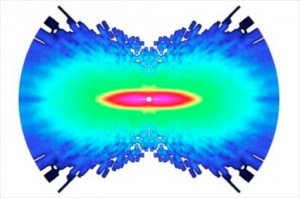
Extracted skin & blood cells can be turned into neurons (red) via stem cells (green). The cells (shown with blue nuclei) are from a patient with Timothy syndrome. Credit: Dolmetsch Lab/Stanford U. Image from C&EN.
This week, C&EN has an interesting summary of the current progress of autism research. As autism diagnoses have become more common, the number of research groups focusing on the biological basis of the disorder have grown all the more numerous. In the article, a number of researchers speak with the magazine about their current research interests and how they might fit together to explain the root causes of the dysfunction.
Most of the researchers they spoke with focus their attention on synaptic proteins. These proteins are involved in transmitting signals from one neuron to another across junctions called synapses. Some of the current protein targets are SHANK3, a scaffolding protein that maintains synaptic signaling complexes, and neuroligin-3, a protein that effects sociability in mice and rodents when mutated. The neurexin family of proteins is also implicated in autism pathways. Neurexins and neuroligin proteins interact with each other to bridge the synaptic junctions and facilitate signal transmission.
The article continues with a discussion of some small molecules with potential as treatments for autism spectrum disorders. These include roscovitine and topotecan which have been used as cancer treatments. Risperidone, which is a current treatment for schizophrenia, is also discussed. These drugs are thought to work by effecting neurotransmitter concentrations or modulating expression of key regulatory proteins.
The magazine article left me with a sense that great strides are being made in the study of autism and the field is ripe with new funding opportunities. Given that most of the current knowledge of autism has mostly been accumulated in the past 10-20 years, there are many unexplored research topics for scientists to pursue.
Links
Source: [C&EN]
Further reading:
- SHANK3 mutations and autistic-like behaviors [Nature]
- Neuroligin-3 R451C mutation alters hippocampal synapses [PNAS]
- Topotecan unsilenses ubiquitin protein ligase E3A expression in neurons [Nature]


 [
[